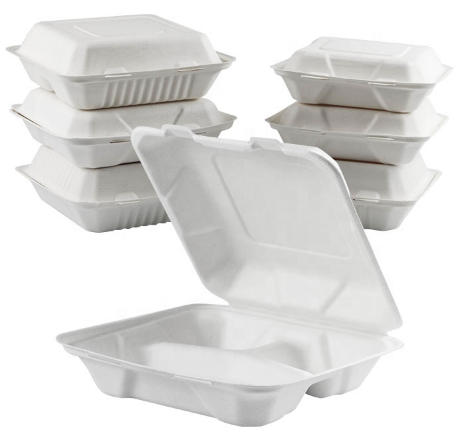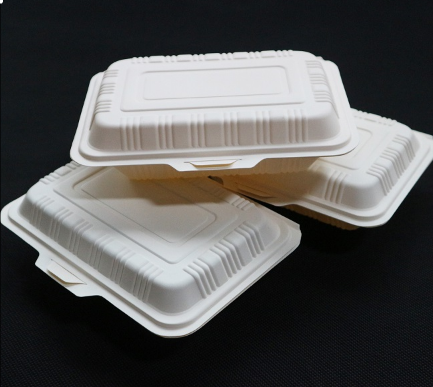Best biodegradable utensils products, you are still worried about unfriendly tableware, I tell you that those are harmful, to protect the environment! We offer degradable disposable tableware.

As shown in the above figure, we provide a degradable sugar cane bar lunch box, edible adhesive, safe and harmless to the human body, the most important thing is that it can be automatically degraded without affecting the environment.Heating in microwave oven.
Plastic hazards
Plastics can take up to a thousand years to decompose, leaving pollutants in soil and water. When plastics break up, they don’t biodegrade; they photolyse, meaning they break down into smaller toxic debris (digested) that contaminate soil, waterways and animals.
Even recycling plastic appliances is difficult and inefficient.best biodegradable plates Most plastic tableware is made of a plastic called polystyrene 1, commonly known as polystyrene foam. Most municipalities do not recycle polystyrene foam, so plastic tableware placed in recycling bins is usually sorted in recycling facilities and sent to landfills.
Best biodegradable utensils Related Products
Biodegradable lunch box eco friendly disposable lunch boxes


Biodegradable food containers Sugarcane food containers


sugarcane takeaway containers sugarcane clamshell food container


Biodegradable food containers malaysia biodegradable food containers canada


“Biodegradable” appliances are not their problem
Botanical, compostable or biodegradable bioplastics, most commonly used in tableware, are sold as sustainable alternatives to disposable plastics. But they are better.
Combining exploration with science, we can solve the plastic pollution by standing paddle board exploration. She explained why plasticity or biodegradable bioplastics, a seemingly good alternative to plastics, might be better than plastics. She also shares her favorite alternatives and solutions that can easily fit into your lifestyle.
Are there any other negative consequences of degradable tableware?
Yes. Creating biodegradable or compostable utensils or tableware does not require significant resources.
Most compostable tableware is made of corn. Maize is a densely growing annual crop, which is usually grown in a single cultivation system. best compostable utensils It must be sown and watered, and soil cultivated. Corn, which is used to make bioplastics, is organic, and many pesticides are also used. The end result is that valuable agricultural land is used to make something thrown away. But we don’t use corn as raw material. Sugarcane basically doesn’t need pesticides!
Then, the environmental costs to be dealt with, and the resources to manufacture and transport products first, will not affect the environment.
Ironically, compostable tableware is usually wrapped in non-biodegradable or recyclable plastic film. Therefore, there are many costs.
Through the comparison of degradable plastics, it is concluded that degradable sugarcane stalks still have the advantage.
They are better than traditional plastic tableware. Virgin plastic tableware is made of petroleum, which is usually not recyclable and may take up to 100 years to begin to decompose. Therefore, if you have to use disposable tableware, absolutely avoid using plastics. If you have to choose between PLA or wood? The latter will give you more help in lowering the pressure knife.
Why? I’m glad you asked. Although more resources are needed to produce wood products, wood has less impact when you look at the entire life cycle of the product. In various studies, from coffee mixers to decorative materials, wood is conventional plastic, although I can’t find figures comparing wood with PLA tableware. According to your view on genetically modified crops, another factor that solves PLA is that it comes from maize, which, like it, probably comes from genetically modified organisms. Sometimes wood appliances treated with wax or other food safety coatings come from fast-growing species such as bamboo and birch. The popular Canadian brand Aspenware even purchased timber from logged trees, leaving the timber industry behind.
However, wooden tableware looks like something in a compost box, so diners are more likely to handle it properly and compost is more likely to accept it. Better yet, you don’t even need a large timber facility to destroy it – interestingly, at least, these things are well stacked in the backyard dustbin (within 90 days, as one claims). You also asked about the ocean, Victoria, which is certainly not garbage, or even compostable garbage. But considering its composition, if it can go to sea, the wooden spoon is likely to decompose faster than a wooden spoon.
But the real advantage of wood is when you finish it. You see, PLA appliances can theoretically be compostable; they decompose under appropriate conditions and leave no toxic dirt behind. But those “right conditions” are the key. PLA does not disintegrate effectively in backyard composting because it requires heat and microorganisms in commercial composting facilities to do its job. Even then, these bioplastic appliances may last longer than the propaganda, as this and this case prove.
It’s helpful to buy only PLA plastics with the logo of the Biodegradable Products Association, because then you will know that the brand has passed a third-party compostability test. But even if Compostable Plastics actually break down as promised, there is no guarantee that they will have an opportunity. The trouble is, Victoria, the PLA looks like ordinary old plastic – so many confused consumers end up putting it in garbage. This confusion extends to industrial composting facilities, where good sorters often mistake PLA items for plastics, pull them out and discard them. As a result, these Compostable Plastics are likely to end up in landfills, where they will emit warming methane instead of realizing their true destiny.
biodegradable food containers eco friendly
Cost-effectiveness
Compared with traditional packaging, our products are more cost-effective, safer to the environment and more valuable for money.
Non-toxic
Our products do not use irritant chemicals. It is safe and non-toxic to humans and ecosystems.
Biodegradable
Biodegradable means only things that can be decomposed or decomposed back into the natural environment without causing harm.
No chemical constituents
Our products are safe, healthy and environmentally friendly because they contain only natural ingredients. This means that the product does not contain synthetic chemicals.
Microwave oven heating
Our products can be used in packaged foods that need to be heated in microwave ovens or traditional ovens. It is safe to use and can withstand high temperature.
Are compostable utensils really compostable?
Wrong. Creating biodegradable or compostable utensils or tableware does not require significant resources. Most compostable tableware is made of corn. Compost tableware is usually wrapped in non-biodegradable or recyclable plastic film.
What are compostable utensils made of?
Composable tableware is made of natural materials such as corn starch or potato starch. They are still a kind of plastics, but because they are made of natural materials found in agriculture, they are called bioplastics.
Supermarket Shopping Label Guide
“Compostable” label
Products labeled “compostable” or “biodegradable” are not allowed to be used in Portland’s compost: they are not always decomposed in compost, do not increase nutritional value, and often lead to more plastic contamination of compost and farms and use of compost gardens. The only exception to this rule is compostable bags for collecting and transporting food waste.
When people see the “compostable” label, they are more likely to put items in the compost and have to be screened out – which can lead to the cost and trouble of composting facilities. Understand why compostable packaging is not required at Oregon composting facilities.
“Compostable” products are not allowed to be recycled. They are designed to break down, contrary to what is needed to make new durable plastic products.
Products labeled “biodegradable” or “compostable” should be put into the trash can. However, although some manufacturers have improved their products’ability to decompose in landfills, when landfills fail, they produce methane, a potent greenhouse gas – so what sounds good is not.
In addition, the environmental impact of “compostable” products may be worse than that of non-compostable products, because they are made from biomass materials, such as corn, which rely heavily on fossil fuel-based inputs for cultivation, processing and transportation [1]. Plastics labeled “compostable” or “biodegradable” are unlikely to reduce plastic pollution in the ocean, as it is not clear whether they are easily decomposed in the marine environment
Bio-base (plant) label
Bio-based packaging is often promoted as a substitute for plastic packaging, which comes from fossil fuels. At present, many biomass materials are made from corn and other crops, which rely heavily on fossil fuel-based inputs for cultivation, processing and transportation.
In the study of bio-based products, compared with non-bio-based products, bio-based products have more than half of the time of higher negative environmental impact.
“Recyclable” label
Outsourcing food packaging in Portland is not recyclable: disposable cups, tableware, tableware and other packaging boxes and containers are garbage, regardless of what they are made of (plastic, paper, bamboo, etc.). The only exception to this rule is round plastic buckets, sometimes used for soups or cooked foods, and tin or metal containers.
When people see “recyclable” labels, they are more likely to put items in recycling bins where they have to be screened – which can bring costs and trouble to recycling facilities.
